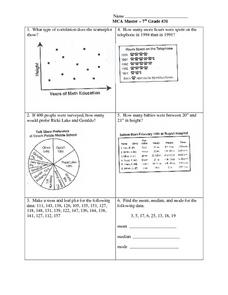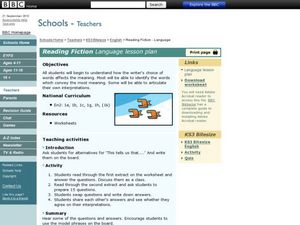Curated OER
How Tall is the Average 6th Grader?
Upper grade and middle schoolers explore mathematics by participating in a measuring activity. They hypothesize on what the average height of a male or female 6th grader is and identify ways to find the average mathematically. Learners...
Curated OER
Suffixes
Many words have suffixes, and knowing them can help scholars with vocabulary and spelling. They read a brief introduction explaining suffixes and giving two examples: -ly and -ful. Then, learners add these suffix examples to seven base...
Curated OER
Introduce Vocabulary: Peter's Chair (Keats)
A new baby means a lot of changes for Peter! Ezra Jack Keats presents this common childhood experience in his story Peter's Chair, the context of a detailed vocabulary study. Before you read, introduce the three new words scholars will...
English Linx
Context Clues Worksheet (Part 1) L.6.4a
Practice using context clues to determine the meaning of words. While the words in this activity are relatively simple, they will help ease pupils into the process of using context clues. Make the activity stronger by asking class...
Curated OER
Making Sense of the Census
Students problem solve the mean and median of agricultural data by completing a worksheet. They discuss the results of the statistical data.
Curated OER
Using Averages
In this math worksheet, young scholars compute the range, mean, median and modal weight of candy bars from two machines. Students write a short essay about which machine is using too much chocolate and which is more reliable.
Curated OER
Density of a Paper Clip Lab Review
Even though this assignment is brought to you by Physics Lab Online, it is best used as a math practice. Middle schoolers calculate the range, mean, mode, and median for a list of eight different paper clip densities. They analyze...
Curated OER
Data Analysis: Graphs, Charts, Tables, Statistics
In this data analysis worksheet, students interpret data in 5 problems involving graphs, tables, and scatterplots. Students construct 1 stem and leaf plot and find the mean, median, and mode of a data set.
Curated OER
Reading Fiction
Explore how a writer's choice of words can convey meaning to the reader. Learners read selections and write questions about the content. Each question is answered by two groups of students and the differences in interpretations are...
Curated OER
See Turtles Nest! See Turtles Hatch!
Students graph data of sea turtles hatching rates from Watamu/Malindi Marine National Park and Reserve in Kenya. In this math lesson, students use real life science data to calculate mean and median values. Students use the data to...
Curated OER
Special Ed. Resource
Ways to organize data is the focus of this math PowerPoint. Students view slides that define and give descriptions of a variety of graphs, and how mean, median, and mode are found. A good visual tool which should benefit almost all types...
Curated OER
Context Clues Worksheet (Part 3)
Ask your pupils to become amateur detectives and use clues to determine the meaning of words. Once they have analyzed the clues, they write the meaning on a provided blank line. If they internalize this process, they can use context...
Curated OER
How Big Is Your Head?
Learners explore measurement by measuring classmates' heads. They record their measurements and they put the measurements in order from smallest to largest. Students figure the mean, median, mode, maximum, minimum, and range of their...
Curated OER
Context Clues Worksheet (Part 2)
One way you can help your learners with reading comprehension is by teaching them how to use context clues to help them figure out the meaning of unfamiliar words. Here is a resource that asks class members to practice that very skill....
EngageNY
Sampling Variability in the Sample Mean (part 1)
How accurate is data collected from a sample? Learners answer this question using a simulation to model data collected from a sample population. They analyze the data to understand the variability in the results.
EngageNY
Using Sample Data to Compare the Means of Two or More Populations II
The 23rd segment in a series of 25 presents random samples from two populations to determine whether there is a difference. Groups determine whether they believe there is a difference between the two populations and later use an...
Florida Center for Reading Research
Vocabulary: Word Analysis, Meaning Map
Lead young learners to understand new vocabulary with this series of word maps. The first of these organizers asks children to determine the definition and provide examples and descriptions of each word with the help of dictionaries,...
Florida Center for Reading Research
Vocabulary: Word Meaning, Undercover Meanings
Support young scholars with studying new vocabulary using this foldable resource. By cutting and folding the included template, learners can record definitions, examples, and a sentence for four different words.
Illustrative Mathematics
Offensive Linemen
Comparing college football teams, Division I is said to have heavier lineman than Division III. Your mathematicians are given data from two different divisions and will have to interpret a dotplot and calculate the difference in weight...
National Clearinghouse for English Language Acquisition
Building Vocabulary: Prefixes, Roots, and Suffixes
Word roots, prefixes, and suffixes can hold the key to determining the meaning of a host of different words. Included here are five pages of prefixes, roots, and suffixes paired with their meanings and example words.
Florida Center for Reading Research
Vocabulary: Word Meaning, Dictionary Cube
Scholars work together to define words and answer questions using a dictionary cube.
Florida Center for Reading Research
Vocabulary: Word Meaning, Inside Information
Support the acquisition of content area vocabulary with this foldable resource. With space for studying three new terms, pupils determine the definition, write a sentence, and provide examples for each word.
Florida Center for Reading Research
Vocabulary: Word Meaning, Word Wrap
Support young learners' acquisition of new vocabulary with this pair of graphic organizers. Using context clues and reference materials, children complete each section of the activity, including the definition, synonyms, examples and...
Wordoful.com
List of Idioms and Phrases
Good idioms are a dime a dozen. A 19-page list is only a drop in the bucket when it comes to figurative language and idiomatic phrases. So don't get a chip on your shoulder and dive in; learning what idioms really mean is a piece of cake!
Other popular searches
- Compound Words Meanings
- Word Meanings
- Prefix Meanings
- Multiple Word Meanings
- Word Meanings in Context
- Words With Double Meanings
- Prefix and Suffix Meanings
- Dinosaur Name Meanings
- Homophones and Their Meanings
- Meanings of Math Symbols
- Meanings of Words
- Foreign Word Meanings

























